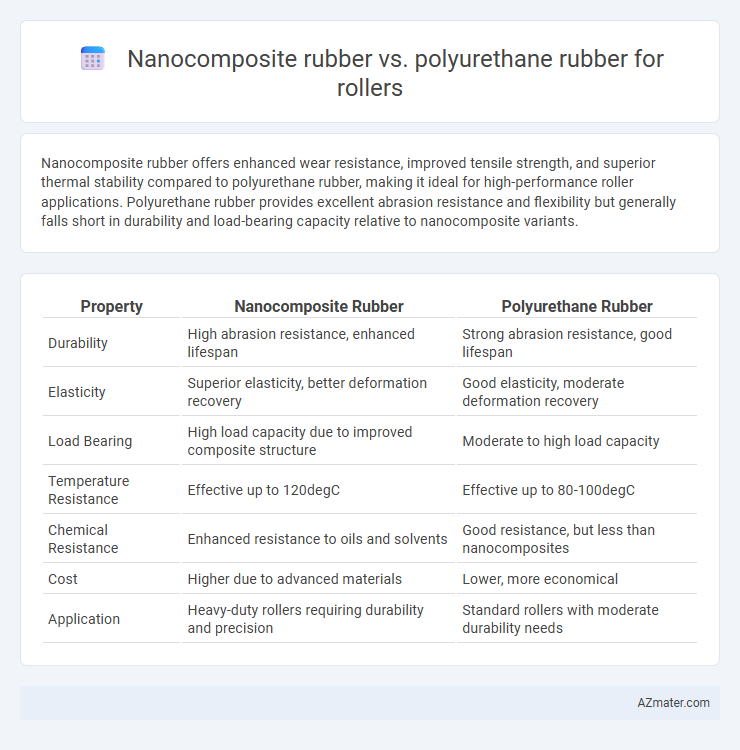Nanocomposite rubber offers enhanced wear resistance, improved tensile strength, and superior thermal stability compared to polyurethane rubber, making it ideal for high-performance roller applications. Polyurethane rubber provides excellent abrasion resistance and flexibility but generally falls short in durability and load-bearing capacity relative to nanocomposite variants.
Table of Comparison
| Property | Nanocomposite Rubber | Polyurethane Rubber |
|---|---|---|
| Durability | High abrasion resistance, enhanced lifespan | Strong abrasion resistance, good lifespan |
| Elasticity | Superior elasticity, better deformation recovery | Good elasticity, moderate deformation recovery |
| Load Bearing | High load capacity due to improved composite structure | Moderate to high load capacity |
| Temperature Resistance | Effective up to 120degC | Effective up to 80-100degC |
| Chemical Resistance | Enhanced resistance to oils and solvents | Good resistance, but less than nanocomposites |
| Cost | Higher due to advanced materials | Lower, more economical |
| Application | Heavy-duty rollers requiring durability and precision | Standard rollers with moderate durability needs |
Introduction to Roller Materials: Nanocomposite Rubber vs Polyurethane Rubber
Nanocomposite rubber and polyurethane rubber are two advanced materials commonly used for rollers in industrial applications, each offering distinct mechanical and chemical properties. Nanocomposite rubber incorporates nanoscale fillers such as carbon nanotubes or silica, enhancing wear resistance, tensile strength, and thermal stability compared to conventional rubber compounds. Polyurethane rubber provides excellent abrasion resistance, elasticity, and load-bearing capacity, making it suitable for high-impact and heavy-duty roller environments.
Composition and Structure of Nanocomposite Rubber
Nanocomposite rubber for rollers consists of a polymer matrix embedded with nanoscale fillers such as silica, carbon nanotubes, or clay, creating a highly cross-linked network that enhances mechanical strength and abrasion resistance. The uniform dispersion of nanoparticles within the elastomeric matrix improves thermal stability and wear properties compared to conventional polyurethane rubber, which typically lacks nanofiller reinforcement. This nano-reinforced composite structure offers superior elasticity and durability, making it ideal for high-performance roller applications requiring extended service life and enhanced load-bearing capabilities.
Polyurethane Rubber: Material Properties and Applications
Polyurethane rubber offers superior abrasion resistance, high tensile strength, and excellent elasticity, making it an ideal material for rollers subjected to heavy loads and continuous wear. Its enhanced chemical resistance and ability to maintain performance under varying temperatures provide durability in industrial environments such as printing, conveyors, and textile machinery. Compared to nanocomposite rubber, polyurethane rubber excels in energy absorption and mechanical toughness, ensuring longer service life and reduced maintenance costs.
Mechanical Strength and Durability: A Comparison
Nanocomposite rubber exhibits superior mechanical strength and enhanced durability compared to polyurethane rubber for roller applications, owing to the homogeneous dispersion of nanofillers that reinforce the polymer matrix. The incorporation of nanoparticles such as silica or carbon nanotubes in nanocomposite rubber significantly improves tensile strength, abrasion resistance, and fatigue performance, extending roller lifespan under demanding operational conditions. Polyurethane rubber offers good elasticity and chemical resistance but generally demonstrates lower wear resistance and mechanical robustness than nanocomposite alternatives in high-stress roller environments.
Abrasion and Wear Resistance: Key Performance Indicators
Nanocomposite rubber exhibits superior abrasion resistance compared to polyurethane rubber, attributed to its enhanced filler dispersion and nano-scale reinforcements that increase surface hardness and durability. Polyurethane rubber offers moderate wear resistance but tends to degrade faster under high-friction conditions due to its polymer chain structure. Key performance indicators such as abrasion rate, wear volume loss, and coefficient of friction consistently favor nanocomposite rubber for roller applications demanding extended service life and resistance to surface damage.
Chemical Resistance in Industrial Environments
Nanocomposite rubber exhibits superior chemical resistance compared to polyurethane rubber, making it more effective in industrial environments exposed to aggressive solvents, oils, and acids. The enhanced barrier properties of nanocomposite rubber reduce permeation and degradation, extending roller lifespan under harsh chemical conditions. Polyurethane rubber, while durable and abrasion-resistant, tends to swell or deteriorate when exposed to strong chemicals, limiting its use in chemically intensive processes.
Heat and Thermal Stability Assessment
Nanocomposite rubber exhibits superior heat resistance and enhanced thermal stability compared to polyurethane rubber, making it ideal for high-temperature roller applications. The incorporation of nanofillers in nanocomposite rubber significantly improves its thermal conductivity and reduces degradation under prolonged heat exposure. Polyurethane rubber, while offering good mechanical properties, tends to soften and degrade faster at elevated temperatures, limiting its thermal endurance in demanding roller environments.
Cost-Effectiveness and Lifecycle Considerations
Nanocomposite rubber offers enhanced durability and wear resistance for rollers, resulting in longer lifecycles and reduced maintenance costs compared to traditional polyurethane rubber. Polyurethane rubber provides lower initial costs but may require more frequent replacement due to its comparatively shorter lifespan. Evaluating total cost of ownership highlights nanocomposite rubber as a more cost-effective option for high-demand roller applications over time.
Application Suitability: Which Rubber for Which Roller?
Nanocomposite rubber exhibits superior abrasion resistance and flexibility, making it ideal for conveyor rollers in heavy-duty industrial applications where high wear and tear occur. Polyurethane rubber offers excellent load-bearing capacity and chemical resistance, suited for precision rollers in environments exposed to oils, solvents, or dynamic mechanical stress. Selection depends on operational demands: nanocomposite rubber excels in durability-focused rollers, while polyurethane rubber is preferred for rollers requiring strong mechanical performance and chemical stability.
Future Innovations in Roller Materials: Trends and Projections
Nanocomposite rubber offers superior wear resistance and enhanced mechanical properties compared to traditional polyurethane rubber, making it a promising candidate for next-generation roller materials. Innovations focus on integrating nanomaterials such as carbon nanotubes and graphene to improve durability, thermal stability, and load-bearing capacity in industrial rollers. Future trends project widespread adoption of nanocomposite formulations to optimize roller performance in high-speed, high-stress manufacturing environments.

Infographic: Nanocomposite rubber vs Polyurethane rubber for Roller
 azmater.com
azmater.com